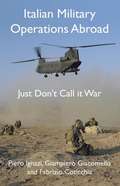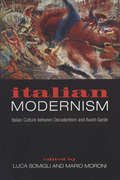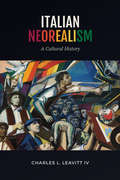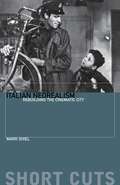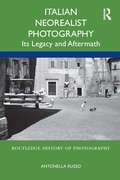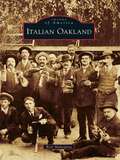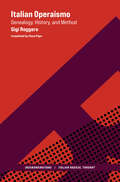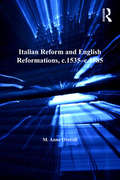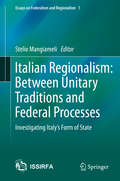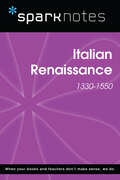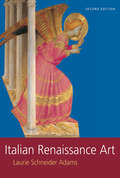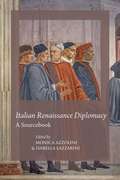- Table View
- List View
Italian Merchants in the Early-Modern Spanish Monarchy: Business Relations, Identities and Political Resources
by Catia Brilli Manuel Herrero SánchezItalian businessmen played a key role in both international trade and finance from the Middle Ages until the first decades of the seventeenth century. While the peak of their influence within and beyond Europe has been thoroughly examined by historians, the way in which merchants from the Italian peninsula reacted and adapted themselves to the emergence of greater commercial and financial powers is mostly overlooked. This collection, based on a vast variety of primary sources, seeks to explore the persisting presence of Florentine, Genoese and Milanese intermediaries in some key hubs of the Spanish monarchy (such as Seville, Cadiz, Madrid and Naples) as well as in eighteenth-century Lisbon. The resilience of powerless merchant nations from the Italian Peninsula in the face of increasing competition in long distance trade is deconstructed by analyzing the merchants’ relational dimension and the formal institutional resources they found in the host societies. By offering new insights into the mechanisms of circulation of men, goods and capital throughout the Iberian world, this book will contribute to better assess the polycentric nature of the Spanish monarchy and, more in general, the complex system of commercial exchanges in the age of the first globalization. This book was originally published as a special issue of the European Review of History/Revue européenne d’histoire.
Italian Military Operations Abroad
by Piero Ignazi Giampiero Giacomello Fabrizio CoticchiaPeace support operations are one of the most important tools in the foreign policy of Western democracies. This book is a study of Italian military operations in the last twenty years. Italy's operations are examined through an analysis of parliamentary debates and interviews with leading policy-makers.
Italian Modern Art in the Age of Fascism (Routledge Research in Art and Politics)
by Anthony WhiteThis book examines the work of several modern artists, including Fortunato Depero, Scipione, and Mario Radice, who were working in Italy during the time of Benito Mussolini’s rise and fall. It provides a new history of the relationship between modern art and fascism. The study begins from the premise that Italian artists belonging to avant-garde art movements, such as futurism, expressionism, and abstraction, could produce works that were perfectly amenable to the ideologies of Mussolini’s regime. A particular focus of the book is the precise relationship between ideas of history and modernity encountered in the art and politics of the time and how compatible these truly were.
Italian Modernism
by Mario Moroni Luca SomigliItalian Modernism was written in response to the need for an historiographic and theoretical reconsideration of the concepts of Decadentismo and the avant-garde within the Italian critical tradition. Focussing on the confrontation between these concepts and the broader notion of international modernism, the essays in this important collection seek to understand this complex phase of literary and artistic practices as a response to the epistemes of philosophical and scientific modernity at the end of the nineteenth century and in the first three decades of the twentieth.Intellectually provocative, this collection is the first attempt in the field of Italian Studies at a comprehensive account of Italian literary modernism. Each contributor documents how previous critical categories, employed to account for the literary, artistic, and cultural experiences of the period, have provided only partial and inadequate descriptions, preventing a fuller understanding of the complexities and the interrelations among the cultural phenomena of the time.
Italian Navy and Air Force Elite Units and Special Forces 1940-45
by Mark Stacey Piero CrocianiThis volume assesses the formidable Special Forces fielded by Italy's navy and air force in World War II. Italian Navy Special Forces were particularly active and respected in the Mediterranean, where 10th Motor-Torpedo Boat Flotilla used frogmen, 'two-man torpedoes' and explosive ram-boats. The Italian Air Force formed a special commando unit, ADRA, before the 1943 surrender; it was tasked with attacking Allied airfields and communications in North Africa. Men from ADRA and Army paratroopers formed the new 'Folgore' Regiment, which also continued to fight alongside German forces until 1945. In both cases, the pro-Allied Italian forces also formed 'mirror' units to fight alongside US and British forces, including the Recce Squadron 'F'. Featuring rare photographs and specially commissioned artwork, this book tells the story of the little-known elite forces fielded by Italy's navy and air force in World War II, some of whose successors remain in service with today's Italian armed forces.
Italian Neorealism: A Cultural History (Toronto Italian Studies)
by Charles L. Leavitt IVNeorealism emerged as a cultural exchange and a field of discourse that served to shift the confines of creativity and revise the terms of artistic expression not only in Italy but worldwide. If neorealism was thus a global phenomenon, it is because of its revolutionary portrayal of a transformative moment in the local, regional, and national histories of Italy. At once guiding and guided by that transformative moment, neorealist texts took up, reflected, and performed the contentious conditions of their creation, not just at the level of narrative content but also in their form, language, and structure. Italian Neorealism: A Cultural History demonstrates how they did so through a series of representative case studies. Recounting the history of a generation of artists, this study offers fundamental insights into one of the most innovative and influential cultural moments of the twentieth century.
Italian Neorealism: Rebuilding the Cinematic City (Short Cuts)
by Mark ShielItalian Neorealism: Rebuilding the Cinematic City is a valuable introduction to one of the most influential of film movements. Exploring the roots and causes of neorealism, particularly the effects of the Second World War, as well as its politics and style, Mark Shiel examines the portrayal of the city and the legacy left by filmmakers such as Rossellini, De Sica, and Visconti. Films studied include Rome, Open City (1945), Paisan (1946), The Bicycle Thief (1948), and Umberto D. (1952).
Italian Neorealist Cinema
by Christopher WagstaffThe end of the Second World War saw the emergence of neorealist film in Italy. In Italian Neorealist Cinema, Christopher Wagstaff analyses three neorealist films that have had significant influence on filmmakers around the world. Wagstaff treats these films as assemblies of sounds and images rather than as representations of historical reality. If Roberto Rossellini's Roma città aperta and Paisà, and Vittorio De Sica's Ladri di biciclette are still, half a century after they were made, among the most highly valued artefacts in the history of cinema, Wagstaff suggests that this could be due to the aesthetic and rhetorical qualities of their assembled narratives, performances, locations, lighting, sound, mise en scène, and montage.This volume begins by situating neorealist cinema in its historical, industrial, commercial and cultural context, and makes available for the first time a large amount of data on post-war Italian cinema. Wagstaff offers a theoretical discussion of what it means to treat realist films as aesthetic artefacts before moving on to the core of the book, which consists of three studies of the films under discussion. Italian Neorealist Cinema not only offers readers in Film Studies and Italian Studies a radically new perspective on neorealist cinema and the Italian art cinema that followed it, but theorises and applies a method of close analysis of film texts for those interested in aesthetics and rhetoric, as well as cinema in general.
Italian Neorealist Photography: Its Legacy and Aftermath (Routledge History of Photography)
by Antonella RussoThis book offers an analysis of the socio-historical conditions of the rise of postwar Italian photography, considers its practices, and outlines its destiny. Antonella Russo provides an incisive examination of Neorealist photography, delineates its periodization, traces its instances and its progressive popularization and subsequent co-optation that occurred with the advent of the industrialization of photographic magazines. This volume examines the ethno(photo)graphic missions of Ernesto De Martino in the deep South of Italy, the key role played by the Neorealist writer and painter Carlo Levi as "ambassador of international photography", and the journeys of David Seymour, Henry Cartier Bresson, and Paul Strand in Neorealist Italy. The text includes an account the formation and proliferation of Italian photographic associations and their role in institutionalizing and promoting Italian photography, their link to British and other European photographic societies, and the subsequent decline of Neorealism. It also considers the inception of non-objective photography that thrived soon after the war, in concurrence with the circulation of Neorealism, thus debunking the myth identifying all Italian postwar photography with the Neorealist image. This book will be particularly useful for scholars and students in the history and theory of photography, and Italian history.
Italian Oakland (Images of America)
by Rick MalaspinaOakland, the other city by the bay, was a magnet for Italian immigrants in the early decades of the 20th century. Some relocated from San Francisco after the devastating 1906 earthquake and fire; many more came to Oakland predominantly from Italy's northern regions of Piedmont, Liguria, and Lombardy in search of opportunity and prosperity. These pioneers worked hard, typically at backbreaking labor, to build new lives. They raised a generation of children who succeeded in their own right and contributed in various ways to their community and nation. As they established new roots and adopted new ways, congregating largely in north Oakland's vibrant and bustling Temescal neighborhood, these Italian Americans also nurtured their Old Country customs and traditions--many of which, along with rare glimpses of bygone days, are portrayed in this charming trip through time.
Italian Operaismo: Genealogy, History, Method (Insubordinations: Italian Radical Thought)
by Gigi RoggeroAn accessible, introductory presentation of operaismo, one of the most important revolutionary theories and praxes of the twentieth century.&“Operaismo is a Machiavellian return to first principles: it is a return to Marx against Marxism, against its tradition of determinism, historicism, and objectivism. Operaismo isn&’t a heresy within the Marxist family, it is a rupture with that family.&”—extract from Italian Operaismo This accessible, introductory presentation of operaismo (or &“workerism&” in English) arms readers with a deeper understanding of the concepts, context, and history of one of the most important revolutionary theories and praxes of the twentieth century. While the ideas of some of its proponents—above all, Antonio Negri—have circulated widely in the English-speaking world over the past twenty years, rather less is known about the context from which (and against which) these perspectives originally emerged. Gigi Roggero here introduces that broader workerist project, and examines how its various analyses of modern social structures, and the possibility for changing them, related to a potent social movement in Italy during the 1960s and 1970s. Italian Operaismo provides a clear overview of the central moments in that tendency&’s development—from the Italian labor movement&’s crisis of direction in the 1950s, the encounter with the &“new forces&” within the working class at FIAT and elsewhere in the early 1960s, and the political journals Quaderni rossi and Classe operaia, to the experience of Potere Operaio and other organizations a decade later. For readers more familiar with this story, the book provides a rereading of operaismo that is both salutary and provocative, one that stresses above all the role within it of subjectivity and political engagement, demonstrating the continued relevance of its subversive method as a tool for reworking the categories of radical and revolutionary thought. This book will serve as a compact, essential work on how to go about eliminating the gap between theory and practice.
Italian Partisans and British Forces in the Second World War: Working with the Enemy (Italian and Italian American Studies)
by Nicola CacciatoreThis book proposes a significant new interpretation of the relations between Italian partisans and British forces during the Italian campaign of 1943-1945. The core of the argument challenges many assumptions that are today still present both in Italian and in the Anglophone historiography on the subject. In current historiography, the debate is still ongoing as to whether the British were a hostile force to the Italian Resistance, trying to weaken it to better control it, or a genuine and committed ally. Instead of a clear-cut and artificial dichotomy between the 'Italians' and the 'British' this book posits the idea that lines were often blurred, and relations existed on a scale that included lots of grey and overlapping areas. Thanks to an original approach that examines the Italo-British interaction from a point of view as close as possible to the ‘action’, it proposes a new interpretation based on the way the British image was cast in Italy. Politics is left in the background in favour of an analysis of the concrete problems and difficulties that Italians and the British had to face when working together and how these processes influenced the image of Great Britain in Italy in the following decades. This produces a final interpretation that enriches current historiography and pushes forward our understanding of the relationship between Italian partisans and British forces.
Italian Political Cinema: Figures of the Long ’68
by Mauro ResminiAn exploration of how film has made legible the Italian long &’68 as a moment of crisis and transitionTraditionally, the definition of political cinema assumes a relationship between cinema and politics. In contrast to this view, author Mauro Resmini sees this relationship as an impasse. To illustrate this theory, Resmini turns to Italian cinema to explore how films have reinvented the link between popular art and radical politics in Italy from 1968 to the early 1980s, a period of intense political and cultural struggles also known as the long &’68.Italian Political Cinema conjures a multifaceted, complex portrayal of Italian society. Centered on emblematic figures in Italian cinema, it maps the currents of antagonism and repression that defined this period in the country&’s history. Resmini explores how film imagined the possibilities, obstacles, and pitfalls that characterized the Italian long &’68 as a moment of crisis and transition. From workerism to autonomist Marxism to feminism, this book further expands the debate on political cinema with a critical interpretation of influential texts, some of which are currently only available in Italian.A comprehensive and novel redefinition of political film, Italian Political Cinema introduces its audience to lesser-known directors alongside greats such as Pasolini, Bertolucci, Antonioni, and Bellocchio. Resmini offers access to untranslated work in Italian philosophy, political theory, and film theory, and forcefully advocates for the continued artistic and political relevance of these films in our time.
Italian Rapier Combat: Capo Ferro's 'Gran Simalco'
by Jared KirbyThe classic treatise on the art of fencing by the seventeenth-century master, in a fresh translation featuring more than forty beautiful illustrations. The Italian fencer Ridolfo Capo Ferro was a legend in his own lifetime. His grace and style were emulated throughout a Europe, and his detailed instruction offers a window into his mastery of swordsmanship. This new translation is faithful to the original text while making it accessible to modern readers. It also includes a new introduction and a revised glossary with many newly translated technical terms. Capo Ferro begins by examining the rapier in detail—its component parts and their suitability—before discussing their actual use. He details the timing and distance needed to control one&’s adversary, the importance of quick footwork, and defensive tactics such as guards and parries. He also covers using the rapier with auxiliary weapons such as the dagger, cloak, and shield. Presented by fencing master Jared Kirby, Italian Rapier Combat is both a vital historical record and an essential guide for any student of fencing.
Italian Reform and English Reformations, c.1535–c.1585 (Catholic Christendom, 1300-1700)
by M. Anne OverellThis is the first full-scale study of interactions between Italy's religious reform and English reformations, which were notoriously liable to pick up other people's ideas. The book is of fundamental importance for those whose work includes revisionist themes of ambiguity, opportunism and interdependence in sixteenth century religious change. Anne Overell adopts an inclusive approach, retaining within the group of Italian reformers those spirituali who left the church and those who remained within it, and exploring commitment to reform, whether 'humanist', 'protestant' or 'catholic'. In 1547, when the internationalist Archbishop Thomas Cranmer invited foreigners to foster a bolder reformation, the Italians Peter Martyr Vermigli and Bernardino Ochino were the first to arrive in England. The generosity with which they were received caused comment all over Europe: handsome travel expenses, prestigious jobs, congregations which included the great and the good. This was an entry con brio, but the book also casts new light on our understanding of Marian reformation, led by Cardinal Reginald Pole, English by birth but once prominent among Italy's spirituali. When Pole arrived to take his native country back to papal allegiance, he brought with him like-minded men and Italian reform continued to be woven into English history. As the tables turned again at the accession of Elizabeth I, there was further clamour to 'bring back Italians'. Yet Elizabethans had grown cautious and the book's later chapters analyse the reasons why, offering scholars a new perspective on tensions between national and international reformations. Exploring a nexus of contacts in England and in Italy, Anne Overell presents an intriguing connection, sealed by the sufferings of exile and always tempered by political constraints. Here, for the first time, Italian reform is shown as an enduring part of the Elect Nation's literature and myth.
Italian Regionalism: Between Unitary Traditions and Federal Processes
by Stelio MangiameliThe object of this book is to describe the institutional modifications of the Italian form of state more than ten years after the review of Title V - Part II of the Italian Constitution - for an audience that goes well beyond the Italian national boundaries. The fifteen essays that make up the book discuss the birth and evolution of the Italian regionalism (including those regions with Special Statutes) as well as reforms of 1999-2001. A particular attention is devoted to the role of autonomy in defining regional statutes, regional forms of government, and regulatory and administrative powers. These are subjects on which there is by now an abundant body of constitutional case law, which is extensively referred to by the chapters. The role of the regions vis-à-vis the local bodies and vis-à-vis the European and international order is also discussed, as the right to negotiate with foreign powers has now been conferred on the regions. Lastly, the volume presents contributions on regional finance and on the new law on fiscal federalism, as well as on regional powers in the area of health and welfare.
Italian Renaissance (SparkNotes History Notes)
by SparkNotesItalian Renaissance (1330-1550) (SparkNotes History Note) Making the reading experience fun! SparkNotes History Guides help students strengthen their grasp of history by focusing on individual eras or episodes in U.S. or world history. Breaking history up into digestible lessons, the History Guides make it easier for students to see how events, figures, movements, and trends interrelate. SparkNotes History Guides are perfect for high school and college history classes, for students studying for History AP Test or SAT Subject Tests, and simply as general reference tools.Each note contains a general overview of historical context, a concise summary of events, lists of key people and terms, in-depth summary and analysis with timelines, study questions and suggested essay topics, and a 50-question review quiz.
Italian Renaissance Art
by Laurie Schneider AdamsArt historian Laurie Schneider Adams brings to students a vibrant and engaging presentation of Renaissance art history that is supported by up-to-date scholarship and methodology. The text opens with the late Byzantine work of Cimabue and concludes with the transition to Mannerism. The author's focus is on the most important and innovative artists and their principal works, with a clear emphasis on selectivity and understanding. Italian Renaissance Art also focuses on style and iconography, and on art and artists, incorporating different methodological approaches to create a wider understanding and appreciation of the art. Distinguishing features of this text include: Over 400 illustrations, with 215 in full color, are integrated with the text, and large enough to properly view. In depth coverage on the most important and innovative artists and their principle works throughout Italy. Side boxes that provide additional material on techniques, biographical data, descriptions of artistic media, as well as necessary background information are used in every chapter. "Controversy" boxes introduce some of the ongoing scholarly quarrels among Renaissance art historians. Maps, plans, and diagrams are also included throughout. A historical chronology, a full glossary of art-historical terms, and a select bibliography are also included at the end of the text.
Italian Renaissance Art
by Laurie Schneider Adams"The chronology of the Italian Renaissance, its character, and context have long been a topic of discussion among scholars. Some date its beginnings to the fourteenthcentury work of Giotto, others to the generation of Masaccio, Brunelleschi, and Donatello that fl ourished from around 1400. The close of the Renaissance has also proved elusive. Mannerism, for example, is variously considered to be an independent (but subsidiary) late aspect of Renaissance style or a distinct style in its own right."
Italian Renaissance Art (Icon Editions Series #Second Edition)
by Laurie Schneider AdamsNow thoroughly revised and updated throughout, featuring extended discussions of Mannerism and the expanding role of women in the visual arts and significant illustration program enhancements, Italian Renaissance Art is a readable, student-friendly, lavishly-illustrated introduction to one of the greatest periods of artistic genius in western history.
Italian Renaissance Art: Understanding its Meaning
by Christiane L. Joost-GaugierRichly illustrated, and featuring detailed descriptions of works by pivotal figures in the Italian Renaissance, this enlightening volume traces the development of art and architecture throughout the Italian peninsula in the fifteenth and sixteenth centuries. A smart, elegant, and jargon-free analysis of the Italian Renaissance – what it was, what it means, and why we should study it Provides a sustained discussion of many great works of Renaissance art that will significantly enhance readers’ understanding of the period Focuses on Renaissance art and architecture as it developed throughout the Italian peninsula, from Venice to Sicily Situates the Italian Renaissance in the wider context of the history of art Includes detailed interpretation of works by a host of pivotal Renaissance artists, both well and lesser known
Italian Renaissance Diplomacy: A Sourcebook
by Isabella Lazzarini Monica Azzolini"Diplomacy has never been a politically neutral research field. The most recent research is moving away from diplomacy as an institutional tool and is increasingly viewing it as a social and cultural practice that enabled Europeans and non-Europeans alike to engage with each other in formal and informal, state and non-state contexts, through the elaboration of common languages, shared practices of communication, and political cultures. Since the nineteenth century, Renaissance Italy has been on the front line of diplomatic research. Italian polities have provided excellent case studies for the theory associating the beginnings of permanent diplomacy and the emergence of resident ambassadors with the process of state-building. Diplomacy during the period from about 1350 to about 1520 increasingly experimented with new ways of answering urgent political needs--to represent, negotiate, participate, and keep informed--by developing a broad range of innovative solutions that had to be integrated and absorbed within the traditional jurisdictional framework of medieval diplomacy. During the fifteenth century, diplomatic sources multiplied at an unprecedented rate, mostly due to the remarkable volume of dispatches exchanged between governments and envoys sent abroad for increasingly prolonged missions. The present book draws on these rich diplomatic sources, which are mostly unavailable to English readers. Most of the chapters present a selection of dispatches, either in their final version or in draft form; occasionally, instructions, letters of appointment, and final reports are added. The published and unpublished sources presented in English translation by the contributors to this volume cover a broad chronological and geographic arc. The aim is to illustrate the richness of diplomatic documents both for the study of diplomacy itself as well as for other less obvious areas such as gender and sexuality, crime and justice, art and leisure, and medicine. The potential for further study is practically infinite. The modest aim of this volume is to enrich classroom discussion and to bring diplomatic documents into focus for scholars and students interested in the Italian Renaissance more generally."--
Italian Renaissance Utopias: Doni, Patrizi, and Zuccolo (Palgrave Studies in Utopianism)
by Antonio DonatoThis book provides the first English study (comprehensive of introductory essays, translations, and notes) of five prominent Italian Renaissance utopias: Doni’s Wise and Crazy World, Patrizi’s The Happy City, and Zuccolo’s The Republic of Utopia, The Republic of Evandria, and The Happy City. The scholarship on Italian Renaissance utopias is still relatively underdeveloped; there is no English translation of these texts (apart from Campanella’s City of Sun), and our understanding of the distinctive features of this utopian tradition is rather limited. This book therefore fills an important gap in the existing critical literature, providing easier access to these utopian texts, and showing how the study of the utopias of Doni, Patrizi, and Zuccolo can shed crucial light on the scholarly debate about the essential traits of Renaissance utopias.
Italian Renaissance, The: The Origins of Intellectual and Artistic Change Before the Reformation
by John StephensIn this fascinating study, John Stephens inteprets the significance of the immense cultural change which took place in Italy from the time of Petrarch to the Reformation, and considers its wider contribution to Europe beyond the Alps. His important analysis (which is designed for students and serious general readers of history as well as the specialist) is not a straight narrative history; rather, it is an examination of the humanists, artists and patrons who were the instruments of this change; the contemporary factors that favoured it; and the elements of ancient thought they revived.
Italian Silent Cinema: A Reader
by Giorgio BertelliniItalian Silent Cinema: A Reader explores the largely forgotten world of Italian silent cinema, including its historical epics, comedies, serials, and romance melodramas. Thirty essays by leading scholars examine topics such as pre-cinema, international distribution, stardom, acting styles, literary adaptation, futurism, nonfiction filmmaking, and local exhibition. This groundbreaking and richly illustrated volume introduces scholars and students alike to a wealth of films, archival documents, and critical research.

